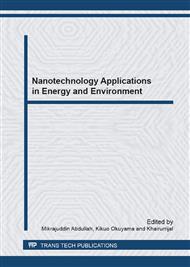[1]
H. Ozbek and S. L. Philips. Thermal conductivity of aqueous NaCl Solution from 20℃ to 330℃. (1979)
Google Scholar
[2]
O.M.M. Eltom and A.A.M. Sayigh. A simple method to enhance thermal conductivity of charcoal using some additives. Renew. Ener. 4 (1994) 113-118
DOI: 10.1016/0960-1481(94)90072-8
Google Scholar
[3]
S.U.S. Choi. Enhancing thermal conductivity of fluids with nanoparticles. Proceeding of the 1995 ASME International Mechanical Engineering Congress and ExpositionSan Francisco, CA, USA (1995)
Google Scholar
[4]
W. Yu, D.M. France, J.R. Routbort, and S.U.S. Choi. Review and comparison of nanofluid thermal conductivity and heat transfer enhancements. Heat. Transf. Eng. 29 (2008) 432-460.
DOI: 10.1080/01457630701850851
Google Scholar
[5]
C. S. Jwo and T. P. Teng. Experimental study on thermal properties of brines containing nanoparticles. Rev. Adv. Mater. Sci. 10 (2005) 79-83.
Google Scholar
[6]
S.J. Kim, et al. Surface wet ability change during pool boiling of nanofluids and its effect on critical heat flux. Int. J. Heat Mass Transf. 50 (2007) 105-4116.
DOI: 10.1016/j.ijheatmasstransfer.2007.02.002
Google Scholar
[7]
S.N. Vijayan, M. Makeshkumar, and K. Sridhar. Physical and chemical analysis of activated carbon preparation from coconut shell charcoal and usage-a case study. Int. J. Adv. Sci. Res. Technol. 3 (2012) 168-175.
Google Scholar
[8]
H. Kim, J. Kim, and M. Kim. 2005. Experimental study on chf characteristics of water-TiO2 nanofluids. Nucl. Eng. Technol. 38 (2006) 61–68.
Google Scholar
[9]
S. André, et al. Hot wire method for the thermal characterization of materials: inverse problems application. Engenharia Térmica. 4 (2003) 55-64.
Google Scholar
[10]
E.J. Wasp, J.P. Kennej, and R.L. Gandhi. Solid-liquid flow, slurry pipeline transportation: slurry pipeline design. 1st ed. Trans Tech Publ., 2007, pp.9-32.
Google Scholar
[11]
Y. Nagasika and A. Nagasima. Absolute measurement of the thermal conductivity of electrically conducting liquids by the transient hot-wire method. J. Phys. E: Sci. Instr. 14 (1981) 1435-1440.
DOI: 10.1088/0022-3735/14/12/020
Google Scholar
[12]
M. H. Sharqawy, J. H. Lienhard V, and S. M. Zubair. Desalination Water Treat. 16 (2010) 354-380.
Google Scholar
[13]
J. Bozicevic, et al. Determination of thermal conductivity in liquids by monitoring transient phenomenon. Proceedings, XVII IMEKO World Congress, 2003, pp.1699-1701.
Google Scholar
[14]
P. Keblinski et al. Int. J. Heat Mass Transf. 45 (2002) 855-863.
Google Scholar
[15]
D. Hemanth Kumar, et al. Model for heat conduction in naofluids. Phys. Rev. Lett. 93 144301-1-144301-4
Google Scholar
[16]
Q. Z. Xue. Model for effective thermal conductivity of nanofluids. Phys. Lett. A 307 (2003) 313-317.
Google Scholar
[17]
Masturi et al. Resistors network model of bcc cell for investigating thermal conductivity of nanofluids. AIP Conference Proceedings 1415 (2011) 86 – 89.
DOI: 10.1063/1.3667227
Google Scholar


